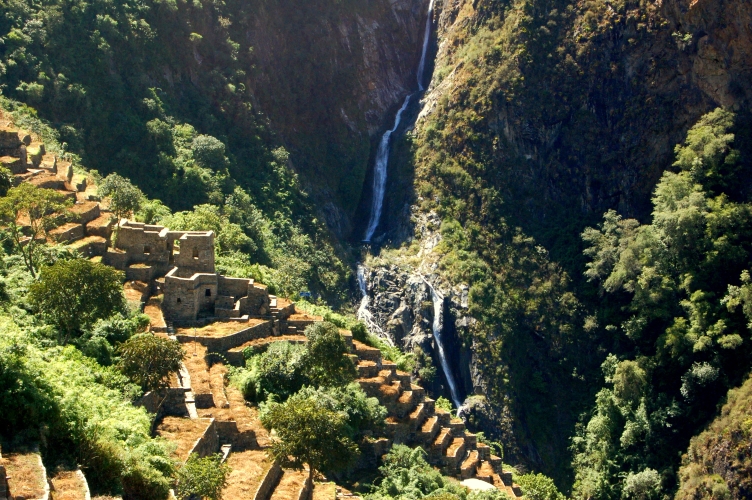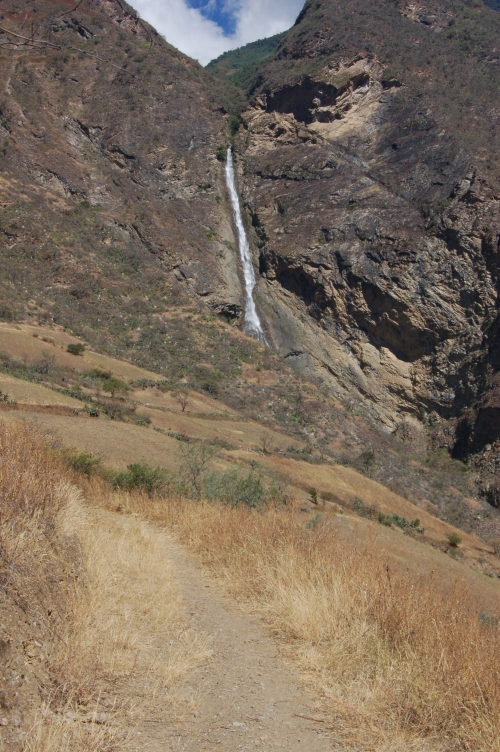There are 3 sites widely regarded as the most important Inca ruins. Machu Picchu is by far the most well-known, studied, excavated, restored and easiest to access. Vilcabamba, the last Inca retreat during the Spanish war is technically accessible but has remained largely buried in the jungle since its rediscovery in the 1960s. Choquequirao’s current status is somewhere between those 2.
There are plans for a cable car or train in the coming decades, but currently the only way to access Choquequirao is an arduous 4-day trek there and back to the edge of civilization. After a 4-hour bus ride and 30-minute taxi ride from Cusco, you reach the small town of Cachora which has some hospedajes and a pollipaperia (hole in the wall serving up plates of french fries and fried chicken.) Cachora serves as the start of the hike. You can also hire mules here to carry your bags, but we decide to do it ourselves.
The first day of hiking is the “easy” day, where you only ascend 1500 feet and descend 4500 feet over a period of 12 miles. What complicates matters is the intense high-altitude sun reflecting off the dry, rocky landscape and the fear of falling into cactus.
Things get interesting on the second day which while only 6 miles begins with a steep 1000 foot drop before beginning a 5000 foot ascent. Fortunately, that trail quickly climbs into cloud forest, providing relief from the glaring sun. At the top of the climb, you can finally get your first good view of the ruins and while still a couple miles away they appear to be a relatively flat walk. Still, at noon, we have already been walking for 6 hours with our camping supplies on our back. We take advantage of the family-run campsites which provide basic meals of rice, eggs, and lentils, and relax for the rest of the day.
The next day, as we begin our short walk to the ruins, each bend unveils new sections from the citadel at the top down to the farming terraces barely perched above a sheer cliff face. We are ecstatic to drop off our bags before spending the day traipsing up and down the mountain searching out remote ruins.
The highlight of Choquequirao (and the draw for us to do this trek) is the llama terraces. They are the sole example of Inca’s incorporating art and religion into their stone walls. There are signs of active excavation and restoration works throughout the entire site. The llama terraces are currently receiving the most attention though with at least 10 full-time people working to clean and restore them. We were lucky to find the informative and talkative supervisor who explained the process of applying a plaster to the stones to brighten them and showed us the recent excavations.
It’s estimated that 70% of Choquequirao is still undercover, but even now it’s an overwhelming site about 3 times as large as Machu Picchu. After a full day of following aqueducts, entering maze-like chambers of temples, and pushing our legs to the limits on the giant steps of the Inca terraces, we realize we’ve only scratched the surface and could easily spend another day exploring this massive site.
But the next morning, we need to begin our return journey. This is where carrying our own bags pays off. Groups that hired mules were forced to backtrack the same 21 mile route over the next 2 days which gave Cara nightmares.
Instead, we continue down the other side of the mountain with a knee-jarring descent that is too steep for mules. Even with our 6AM start, the sun is already brutal by the time we reach the base of the mountain, leaving us a scorching 6 mile climb to go until the lush lodge of Tambobamba. When we finally reach our destination, we have no shame in paying for a hot shower, drinking beers in hammocks all afternoon, and sleeping soundly in a bed. To top it off, the friendly lodge owner lets us tag along the next day on his drive to the tiny town of Huanipaca. From there, we take a 20-mile shared taxi up, up, and away and end up at a paved road where we successfully flagged down a sporadically passing bus headed home to Cusco a few hours away.
In 20 years, more of the Choquequirao ruins will be uncovered and the route will be easier (but don’t hold your breath on the train.) For now, however, this imposing journey and rustic camping are inseparable from a visit to these spectacular ruins and help limit visitors to about 10 per day. Given the wealth of Peruvian archaelogical wonders, in 80 years, Machu Picchu will be old hat; there will be a train even to Vilcabamba, and some site no one has ever heard of will be a new 7th wonder of the world.



Leave a Reply